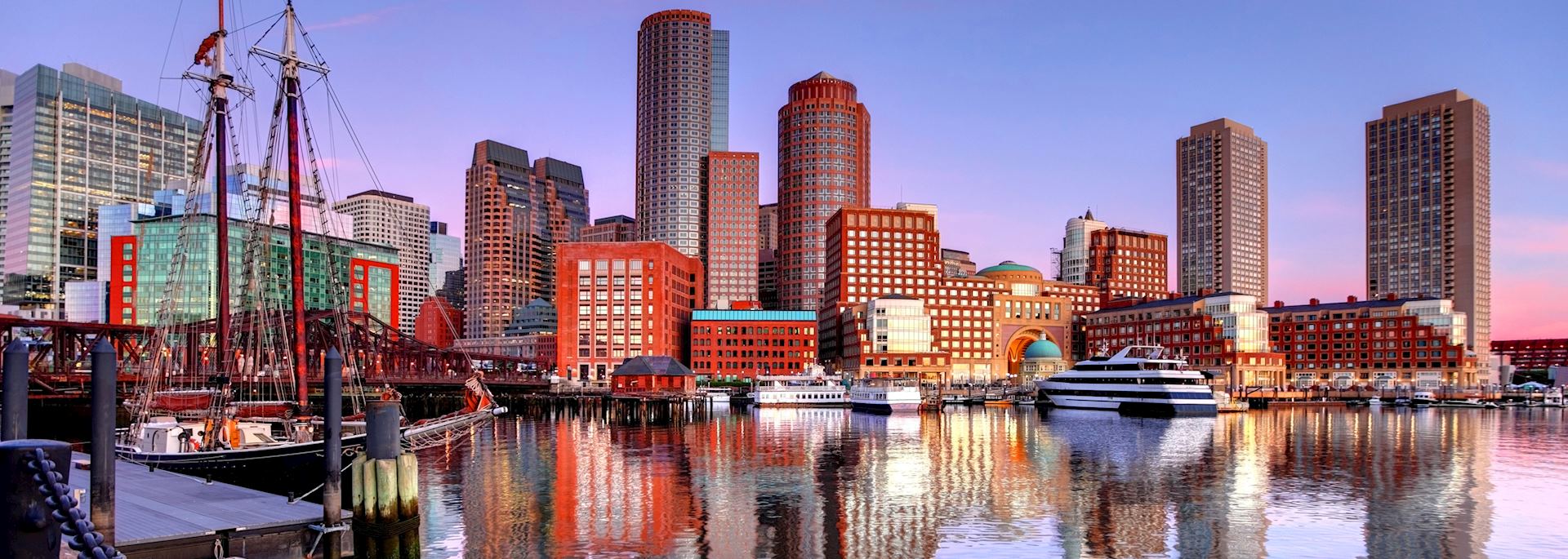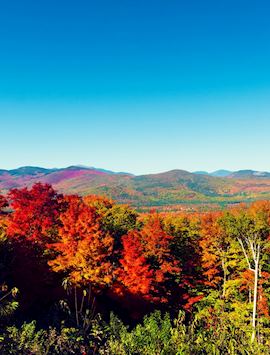By USA specialist Molly
As one of America’s oldest cities, Boston wears its history proudly. Colonial red-brick buildings and Victorian brownstone townhouses stand next to early skyscrapers. City burial grounds are filled with the illustrious dead, their graves marked by weather-worn headstones engraved with winged skulls.
The American Revolution was born here, from the first stirrings at the Boston Tea Party to the forthright defiance of the reading of the Declaration of Independence from the balcony of the Old State House.
This plethora of historic attractions comes in a compact package. Boston’s tangled streets are notoriously difficult to navigate in a car but easy to manage on foot, making it one of the country’s most accessible cities.
Things to see & do in Boston
The Freedom Trail
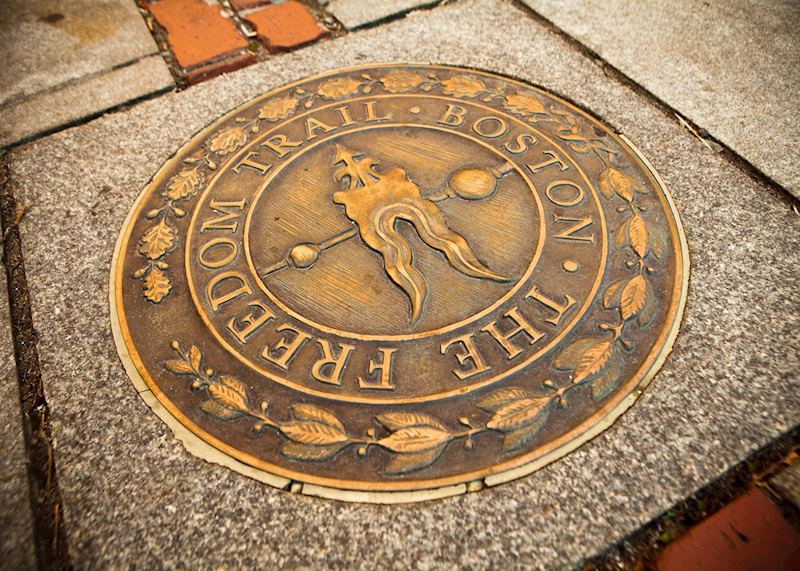
The American Revolution was born on Boston’s narrow, crooked streets and many of the war’s most important historic sites are here, linked by the Freedom Trail. A red painted or red-brick line in the sidewalk, the trail runs for about 4 km (2.5 miles) and takes in more than a dozen sites.
To me, one of the most moving stops on the trail is the site of the Boston Massacre. The innocuous ring of stone and brass embedded in the pavement marks where British soldiers shot and killed five snowball-wielding colonists. The first to die was Crispus Attucks, a man of mixed race who is regarded as the nascent nation’s first martyr.
I like to time the tour so that I reach Faneuil Hall Marketplace at mealtime. The hall itself is an elegantly proportioned red-brick building topped with a bright brass grasshopper weathervane. The adjacent Quincy Market is a triple row of shops, stalls and restaurants, where you can break for a quick lunch or a long dinner.

The last two stops on the trail — the Bunker Hill Monument and the naval frigate USS Constitution — are a long walk from the others and some don’t consider them worth the effort, but I disagree. I particularly like visiting ‘Old Ironsides’, the nickname the Constitution earned when cannonballs seemed to bounce off its oak sides during the War of 1812.
Afterwards, you can take a water taxi back to the New England Aquarium and view the city’s skyline from the water.
New England Aquarium
Sleek sharks and venerable sea turtles swim in slow constant circles around the Giant Ocean Tank, an enormous fishbowl at the heart of the New England Aquarium. Visitors walk up a ramp that spirals around the mind-boggling recreation of a Caribbean reef, watching more than 1,000 fish through transparent panels as they ascend 7 m (23 feet) to the surface.
The aquarium is also the boarding point for whale watches that leave from Boston. The high-speed catamaran takes you to the Stellwagen Bank National Marine Sanctuary, an underwater plateau near Cape Cod that provides a rich feeding ground for marine mammals.
Last time I went I saw more than a dozen humpback whales, gunmetal-gray giants that leaped from the water with a grace that seemed unlikely for such huge creatures.

The tours are narrated by an aquarium expert who explains the science behind these remarkable animals, including their migration patterns and their feeding habits.
The North End
One of the city’s oldest and best-preserved areas, the North End’s narrow streets and hodgepodge of houses have often played home to the city’s latest wave of immigrants — European Jews in the mid-1800s, then Irish and, most recently, Italians.
Today, it’s the place to get a good Italian meal and its streets are packed with restaurants, pizzerias, trattorias and pastry shops that sell a variety of delicacies, including the North End’s signature treat: the cannoli. The title of best cannoli is a hotly debated topic in the city — Mike’s Pastry and Modern Pasty are the leading contenders, both on Hanover Street.
Beacon Hill
Boston’s most desirable address since the early part of the 1800s, Beacon Hill’s gaslit streets are cobbled and steep, with narrow brick sidewalks that are notoriously uneven. The neighborhood covers a rise that ascends from the Boston Common, and the climb is worth the effort to admire the well-maintained brick and brownstone buildings.
Acorn Street is perhaps the prettiest, the brick row houses all sporting matching black shutters and window boxes that spill out bright blooms in spring and summer.
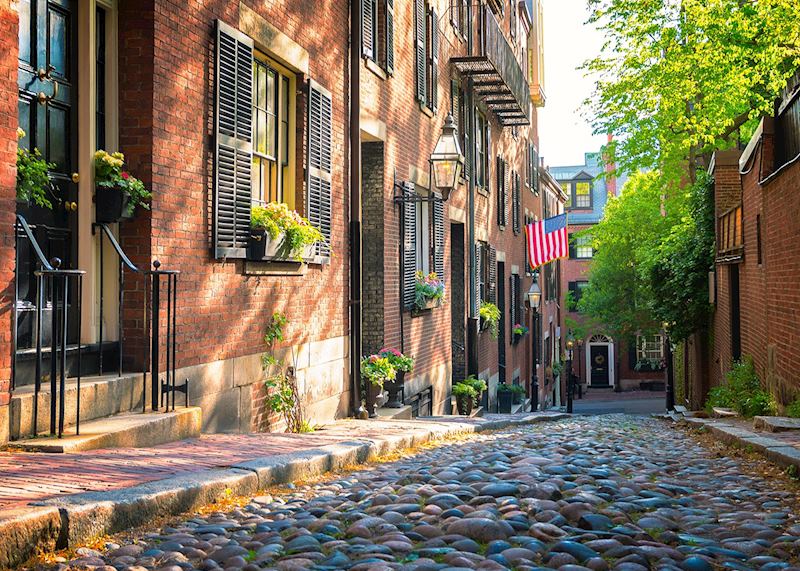
You may notice some purple panes of glass on the older windows. Known locally as ‘lavenders’, they are the result of a batch of glass with too much manganese from the mid-19th century. The glass started out clear but has darkened in the sunlight over the decades. The flaw originally caused much consternation, but now these pansy-hued panes are something of a status symbol.
Public Garden and Boston Common
The carefully groomed flower beds of the Public Garden and the more tattered lawns on the Boston Common together make up the heart of the city’s downtown.
Dating back to 1634, the common is America’s oldest public park. Pirates, witches and Quakers were hanged here and activists have long planted their soapboxes here. Even today, you can expect to see political activists almost any day, ranging from impassioned preachers shouting the gospel to indifferent passers-by, to vast crowds waving signs and chanting slogans.

Directly adjacent to the common, the Boston Public Garden is the country’s oldest public botanical garden. Softly meandering paths wind through and around tidy beds planted with huge swathes of seasonally changing blooms.
Various statues stud the park, including Make Way for Ducklings, the only statue to heroic waterfowl in North America. Nine baby ducks waddle along behind a big brass mama duck, her back smoothed to a high shine thanks to children (and adults) sitting on top of her.
Museums to visit in Boston
Built out of pale-gray granite, Museum of Fine Arts, Boston (the MFA) is the fourth largest museum in the nation. Its vast holdings encompass many cultures and styles, including the largest collection of Japanese works outside Japan and a significant collection of Impressionist art, as well as many pieces by American artists like portraitist John Singleton Copley.
Of course, as befits the self-styled Athens of America, this isn’t the only major museum in the city.
Boston Tea Party Ships and Museum

The story of the Boston Tea Party goes that a group of independent-minded colonists protested a new tax by destroying an entire shipment of tea, declaring ‘No taxation without representation!’. The reality is somewhat more complex, involving smuggling and competing corporate interests.
With interactive displays, costumed staff and recreated tall ships, the Boston Tea Party Ships and Museum helps to unpack this complicated prelude to the American Revolution.
Museum of Science
Though the Museum of Science is technically intended for children, I’m unashamed to say that I thoroughly enjoy visiting. It’s like a sprawling playground, with interactive exhibits that encourage you to get your hands dirty, sometimes literally. When I visited recently, one of the often-changing displays involved examining the many-tentacled microscopic animals in the muddy water drawn from the Charles River.

Isabella Stewart Gardner Museum
A few blocks from the MFA, the Isabella Stewart Gardner Museum is set in a recreated Venetian palazzo. The collection includes a self-portrait by Rembrandt, The Rape of Europa by Titian and The Story of Lucretia by Botticelli.
Alongside these, you also see 13 empty frames that represent the spaces left by an audacious art heist in 1990 that’s still unsolved. The collective worth of the stolen paintings is estimated at $500 million, in what’s purported to be the single largest property theft in history.
For me, the central courtyard is worth the price of admission alone. A graceful garden under a glass ceiling, it’s filled with an ever-changing parade of blooming flowers. If you visit in April, the nasturtium vines are on display, a riotous tumble of bright-orange flowers cascading down from the Moorish-style balconies.
Isabellas take note: Admission is free if you share a first name with the museum’s founder.
Cambridge
Across the Charles River from Boston, Cambridge is a small, wealthy city that’s best known as the home of two of the country’s most prestigious universities: Harvard University and the Massachusetts Institute of Technology (MIT). Harvard Square is arguably the city’s heart, a cosmopolitan enclave where high-end boutiques and student-priced dives stand next to comic book shops and trendy eateries.
In the middle of this urban bustle, it’s almost shocking to go through a wrought iron gate and enter into Harvard University’s renowned yard. Shady and spacious, the green enclosure is bordered by stately brick buildings and populated by equal numbers of squirrels and students.
The statue of the university’s namesake, John Harvard, has one shiny shoe that’s kept polished by hands touching it for luck. For an irreverent take on the sometimes stuffy school, the Hahvahd Tour offers cheekily narrated tours of the ivied campus. (The odd spelling is a wink to the classic Harvard accent.)

The university has a wide variety of small but exceptional museums. At the Harvard Museum of Natural History, I’m particularly fond of the display of glass flowers once used by botany students as study aids.
Nearby, the MIT campus is larger and a little tricky to navigate, but an interesting destination if you enjoy architecture. The mishmash of styles includes the Green Building, a brutalist skyscraper by IM Pei, and the Ray and Maria Stata Center, a jumble of jarring angles designed by Frank Gehry. I always take a moment to peek up at the top of Pantheon-inspired Great Dome if I walk by — the prank-prone students have been known to leave odd objects up there, including a police car.
As home to some of the world’s most cutting-edge technologies and brilliant scientists, MIT’s museum is a geek’s playground. Exhibits include humanoid robots that help NASA test space suits, the world’s largest collection of holography and a comprehensive display of slide rules.
Off-the-beaten-path Boston
Fenway Park
Boston sports fans are fanatically devoted, none more so than the fans of the Red Sox, the local baseball team. Combine that passion with one of the smallest stadiums in Major League Baseball and tickets to Red Sox games can be very hard to get.
However, you can still get a taste of the Red Sox with a tour of their homeground, Fenway Park. The tour includes stories from the team’s long and uneven history. Last time I visited, I got to sit on top of the Green Monster (the towering outfield wall) and see the single red seat in right field, marking where legendary batter Ted Williams hit the longest home run in the park’s history.
The Boston Public Library
‘The Commonwealth requires the education of the people as the safeguard of order and liberty.’ This rather weighty sentiment is inscribed in giant letters on the main branch of the Boston Public Library, the oldest large public library in the nation.

The building reflects the young republic’s regard for the institution, with a grand granite exterior and an interior of richly veined marble, soaring columns and John Singer Sargent murals. The central courtyard is graced with a fountain and surrounded by a pillared arcade that seems lifted from an Italian Renaissance palazzo.
A free, docent-led tour of the collection examines not just books and manuscripts but also maps, paintings, prints, rare musical scores and papers from notable New England residents.
John F Kennedy Presidential Library and Museum
John F Kennedy was arguably New England’s most notable resident in the 20th century, and his presidential library is located in the south of Boston, on manicured grounds overlooking the bay.
IM Pei designed the building, a blandly abstract slab of concrete and glass that contains extensive exhibits about the president’s life and policies. The display that deals with Kennedy’s assassination, playing Walter Cronkite’s solemn voice on constant repeat as he breaks the news of the president’s death, often brings visitors to tears.

Getting around Boston
Boston is one of the most compact and walkable cities on America’s East Coast and it has a decent (by American standards) public transit system, known locally as ‘The T’. You can buy a one-day or one-week pass for admission onto the city’s many buses, subways and ferries.
That’s good, because driving here is a challenge, where you face aggressive drivers, an irregular street plan and an overabundance of one-way streets.
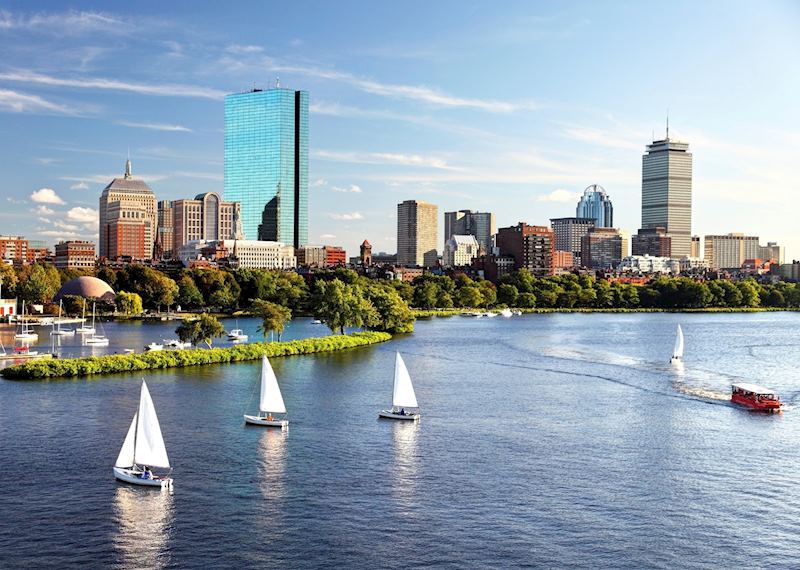
What to eat in Boston
A five-foot long ‘sacred cod’ hangs in the Massachusetts State House, a tribute to the importance of seafood to the Commonwealth and to Boston. Though there is less fishing than there used to be, Boston still serves excellent seafood. Raw oysters, fried clams, baked cod, and fish and chips are all common on menus across the city.
Most people eat lobster rolls in the summer, but they’re available year round. In fact, many locals think lobster is firmer and sweeter in the colder months. Regardless of when you order them, they will be expensive. Most menus coyly list ‘market price’, but diners can expect to spend more than $20, about twice what a sandwich usually costs. And, disruptions in the supply can make the price shoot up dramatically with no warning.

Where to stay in Boston
The Loews Boston Hotel is housed in the former Boston Police headquarters, just a few blocks from the Public Garden. The dignified granite façade hides well-appointed modern rooms and a chic restaurant named the Precinct Kitchen + Bar. When I’m staying here, I like to end my day with a drink at the outdoor seating area.
Located in a former Federal Reserve Bank, the Langham has one of the city’s best locales. As well as being close to Faneuil Hall, the New England Aquarium and the Freedom Trail, it’s a stone’s throw away from the North End’s many fine restaurants. Many of the elegant rooms have a view of the Boston city skyline. The hotel boasts an indoor pool and spa, and you can order a chocolate-themed brunch on Saturdays between November and April.
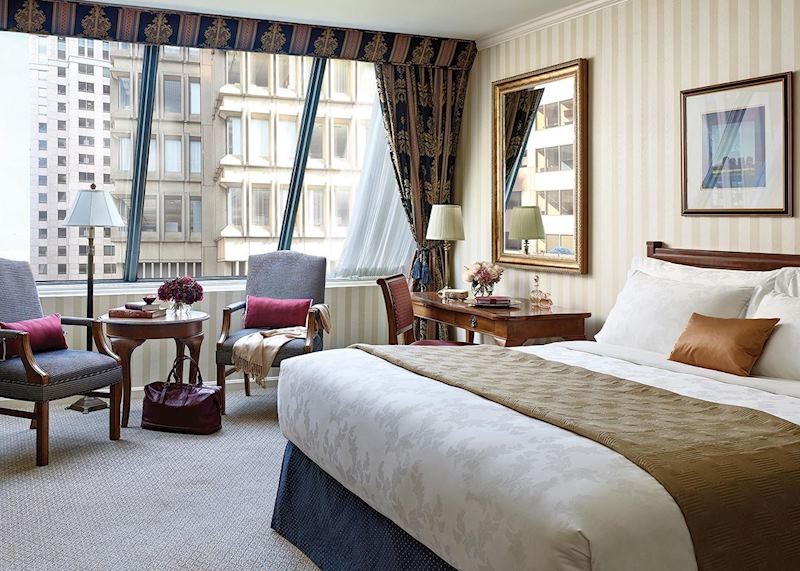
When to visit Boston
I prefer to visit Boston in September and especially October, as the weather cools down and the trees on the common turn brilliant yellow and bright red. April and May are also nice, especially if you want to visit the Public Garden. Summer tends to bring high heat and sticky humidity, along with crowds, and winter is usually cold and messy with snow or rain.
Start planning your trip to Boston
Start thinking about your experience. These itineraries are simply suggestions for how you could enjoy some of the same experiences as our specialists. They're just for inspiration, because your trip will be created around your particular tastes.
View All Tours in New England